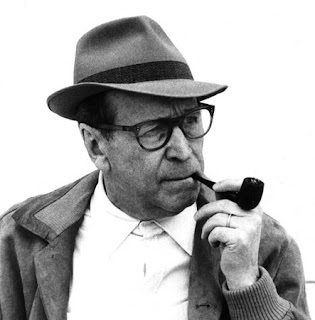Wallace Stegner, Angle of Repose
 When it was published in 1970, Wallace Stegner's Angle of Repose must have seemed like a contemporary novel and a historical novel wrapped into one, with hippies and miniskirts on one page and pioneers and corsets on another. Fifty years later it reads like a historical novel all the way through.
When it was published in 1970, Wallace Stegner's Angle of Repose must have seemed like a contemporary novel and a historical novel wrapped into one, with hippies and miniskirts on one page and pioneers and corsets on another. Fifty years later it reads like a historical novel all the way through.Lyman Ward is a historian still in his 50s, but because of an amputated leg and otherwise declining health he is retired from teaching. His wife has left him for the surgeon who cut off his leg, and now he is in the care of a neighbor woman, once a childhood playmate, who feeds him and bathes him. This woman's daughter, Shelly, full of hippie ideals and attitudes, comes over each day to help him organize his current writing project, a book about his grandmother, Susan Ward.
Lyman can't decide whether his book should be a biography or a novel. Stegner's novel takes the form of Lyman's recorded narrative, including both the details of his own life and that of his grandmother, as revealed in letters and other documents. But these papers cannot reveal the whole story. Sometimes they only hint at it. Many details, such as conversations, are omitted altogether, and Lyman must use his imagination to fill in the blanks.
Susan is a gifted writer and artist who views Eastern intellectual circles as her Eden. Then she falls in love with Oliver Ward, a mining engineer who is also from the East but whose career takes him West, where the mines are. Reluctantly she follows her husband, always dreaming of returning East and to her dear friends there. Her snobbishness prevents her from forming friendships with anyone in the pioneer towns where Oliver's job takes him.
It doesn't help that Oliver, for all his talent, finds success difficult to achieve. He is much too trusting of others, who then take advantage of him. He fails to patent his inventions, allowing others to make fortunes from them. Susan often supports their growing family herself with her writings and illustrations, much in demand back East. This further deflates Oliver's self-esteem.
Then there is Frank, a young man from the East who, unlike Oliver, can talk with Susan intelligently about books and other subjects that interest her. Frank makes clear his love for Susan. She tries to discourage him, but not in a way that actually discourages him. Her nos sound too much like maybes.
Finally Lyman reaches a point in his grandmother's story where he can't go on. The couple briefly separates after a family tragedy. When they reunite, they remain emotionally distant for the remainder of their long lives. They seem distant even in Lyman's own memories of them. So what happened? Was Susan unfaithful to her husband or not? He cannot decide. His feelings about his grandmother become confused with his feelings about his own wife, and he doesn't know what to do about either woman.
Stegner's it-was-only-a-dream ending spoils an otherwise classic novel. This may have worked for Dorothy, whose dream was in color and much more interesting than Kansas, but it seems cheap and easy here. Surely Stegner could have done better.











